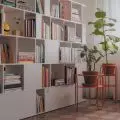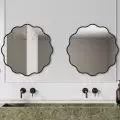The project team under the supervision of Dr. Elżbieta Błeszyńska, consisting of: Patrycja Iskra, Julia Więckowska, Olga Rospondek and Emilia Słowik won second place in the competition "Study of the development of the area intended for residential development in Dąbrowa Górnicza" conducted at the Department of Urban and Spatial Planning of the Faculty of Architecture of the Silesian University of Technology in Gliwice. The designed housing estate is to have the character of a utopian enclave located in the city center. Its overriding goal was to integrate the residential space with nature and to provide intimacy and comfort to the male and female residents.
design guidelines
© Patrycja Iskra, Olga Rospondek, Emilia Słowik, Julia Więckowska
existing condition
The area where the design concept was created is currently unused and overgrown with wild vegetation. The area, despite its location, does not currently serve any utilitarian or recreational function, which negatively affects its potential. The southeastern part of the area is cut by district heating pipes, which are a key element of technical infrastructure for the entire city of Dabrowa Gornicza. The project envisaged hiding these ducts in embankments or slopes, which would not only enhance the aesthetic value of the area, but also improve its functionality, allowing for better landscaping.
There are underground parking lots under some of the district heating pipes, another aspect that affects the functionality of the site. On the northwest side, the site is bordered by irregular single-family housing, the character of which dominates the surrounding areas. The project envisaged supplementing this development with the introduction of additional single-family houses - both detached and row houses, which would relate to the existing urban layout.
The eastern side of the area is bordered by a sewage treatment plant and industrial areas, which posed challenges due to potential sources of noise and odor. To reduce the negative impact of these facilities on future residents and residents, it was proposed to create a recreational and sports zone, additionally serving as a buffer between the industrial and residential areas. Within this zone, sports fields are planned, as well as catering and leisure facilities, increasing the attractiveness of the space.
The central part of the study area is cut by a high-voltage power line, limiting development possibilities. Rather than leaving the area unused, the students proposed creating an embankment with recreational and sports functions, with roller tracks, bicycle paths and rest gazebos. Along the southern boundary of the site runs a watercourse, which the project used to create a retention basin and water channels that serve aesthetic, recreational and protective functions in the context of rainwater management.
regulatory plan
© Patrycja Iskra, Olga Rospondek, Emilia Słowik, Julia Więckowska
main project idea
The goal of the project was to create a sustainable urban space, combining residential functions with elements of nature. Green spaces were planned so that they could serve both daily use and recreation. The introduction of various forms of greenery - from parks to community gardens to street greenery - creates a friendly microclimate and supports biodiversity.
Great emphasis was placed on maintaining the spatial coherence of the neighborhood, in which the various functions - residential, recreational and service - were to be logically integrated. An important element of the design was also the diversity of the site, which made it possible to isolate residential areas from potentially inconvenient zones, such as the sewage treatment plant and high-voltage power lines.
urban structure
The designed residential area is to be accessible from the south, where the main entrance is planned.A one-story service arcade is planned at the entrance, which would be a kind of "gateway" to the estate. Behind the service arcade, multi-family housing was designed, dominating in the southern part of the area. To the north, single-family housing was located, referring to the existing houses.
The tallest buildings, with four stories, are located in the eastern strip, bordering the recreation and buffer zone from the treatment plant. The different types of development are separated from each other by green belts and small embankments, which would provide privacy and visual coherence.
The settlement's compositional layout was based on an axis running from southwest to northeast. This axis separated single-family and multi-family housing, and its central point was to be a water reservoir surrounded by a square. The entire infrastructure around this reservoir was planned on a seven-sided plan, which emphasized the centrality of this place in the composition of the estate.
landscaping
© Patrycja Iskra, Olga Rospondek, Emilia Słowik, Julia Więckowska
natural system
One of the main design assumptions was to preserve the continuity of greenery with the Green Park and the Pogoria area, characterized by intensive green and water areas. Modern solutions of the so-called blue-green infrastructure were applied, combining rainwater management with urban greenery. A system of water channels, distributed throughout the estate, performs retention functions, supports biodiversity and enhances the aesthetics of the space.
utility program
The estate has been designed to meet the diverse needs of male and female residents. In addition to residential zones, service, catering, sports and social spaces were provided to support the daily lives of male and female users.
The development within the estate was intended to be uniform in terms of architectural character - the buildings adopt simple forms with gabled roofs. Low-rise buildings dominated, with a small number of medium-rise multi-family buildings. No high-rise buildings were envisaged in the project, preserving the intimate character of the estate.
The project envisages the creation of spaces conducive to social activity, such as playing fields, roller tracks, playgrounds, as well as catering spaces and integration centers located in the northeastern part of the estate.
landscaping, tall grass vegetation
© Patrycja Iskra, Olga Rospondek, Emilia Słowik, Julia Więckowska



























